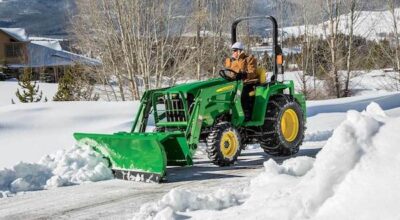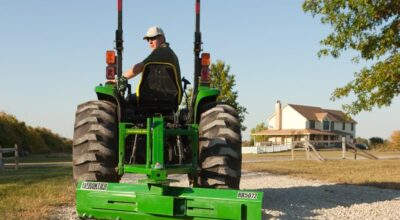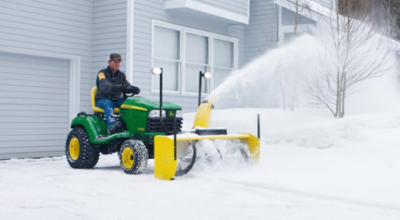A well-maintained gravel driveway isn’t just about aesthetics — it affects everything from vehicle wear to drainage efficiency. But over time, ruts, potholes, and edge erosion are inevitable. With a Frontier three-point box blade, you can restore your driveway quickly and confidently, no contractor required.

This attachment is designed for seamless compatibility with the iMatch™ Category 1 quick-hitch system, allowing for fast, tool-free connection to most compact and utility tractors. With a box-style frame and front and rear blades, it efficiently cuts into uneven terrain, redistributes gravel, and smooths surfaces in just a few passes — ideal for quick jobs and frequent implement changes.
If you’re ready to take driveway upkeep into your own hands, a Frontier three-point box blade is the place to start. In this guide, we’ll break down why a box blade is essential for driveway maintenance, how to use it step-by-step, and how to choose the right fit for your tractor and property.
Key Takeaways
- DIY-Friendly: A three-point box blade lets property owners easily maintain gravel driveways without hiring a contractor.
- Step-by-Step Efficiency: Clear debris, scarify, spread gravel, level with a crown for drainage, and compact the surface.
- Right Fit = Better Results: Choose a box blade with the proper width, weight, and hitch compatibility for your tractor.
- Pro Tips Boost Performance: Grade when gravel is slightly damp, go slow, and maintain your equipment for best results.
- Smart Investment: Reduces long-term repair needs and gives you control over regular driveway upkeep.
Why Use a Three-Point Box Blade for Driveway Work?
A three-point box blade is an ideal tool for homeowners, hobby farmers, and acreage owners who want to maintain their driveways without relying on outside help. The blade uses the machine’s movement — no hydraulics or extra controls — to grade, level, and move gravel with ease.
The Frontier box blade works by cutting into raised areas of gravel and moving that material into lower sections like ruts, potholes, or eroded edges. In one continuous motion, it levels the surface, evenly spreads the material, and backfills to restore the driveway’s shape — all without extra tools or equipment.
It’s also compatible with most compact and utility tractors, so you can put it to work with the equipment you already have. Whether you’re managing a small driveway or a long gravel road, a box blade offers an efficient, do-it-yourself solution for keeping surfaces in shape.
Step-by-Step Process
Regrading is useful for fixing major driveway damage as well as handling routine upkeep. These steps will show you how to prep, grade, and finish the surface, whether you’re working with existing gravel or adding new material.
Prep the Area: Remove Large Debris and Assess Low Spots
Start by walking the driveway to clear away rocks, branches, and any other large debris. During this inspection, keep an eye out for low or sunken areas where water tends to collect. These soft spots usually see the most damage over time and should be your top priority when it’s time to grade.
Scarify if Needed: Break Up Compacted Gravel with Scarifiers (if Equipped)
Now that you’ve cleared the area, it’s time to use scarifiers. Included with several Frontier box blades, these adjustable metal teeth on the front of the attachment dig into compacted gravel and loosen it before grading.
Set the scarifiers just deep enough to reach the bottom of the worst potholes. This will loosen compacted gravel without disturbing the driveway’s foundation underneath.
As you make a few passes, weave slightly from side to side. This keeps the scarifiers from falling into the same tracks each time and ensures you’re breaking up the entire surface equally.
Distribute Gravel: Spread Existing or New Gravel Evenly
With the surface well-churned, raise and lock the scarifiers. Then, begin spreading gravel by lowering the box blade and driving slowly forward. If you’re working with existing gravel, the blade will pull material from raised areas and move it into any dips.
If you’re adding new gravel, apply it in thin layers with overlapping passes to distribute the material consistently. Then use the box blade to blend the gravel with the existing surface to avoid buildup or washouts.
Level and Smooth: Use the Box Blade to Feather Edges and Create Proper Drainage
During the leveling stage, the goal is to create a subtle crown in the center of the driveway — slightly higher in the center and sloping outward — to help water drain off the sides instead of pooling in the middle. Feathering shapes this slope by gradually tapering material from the center outward.
To achieve this, first check that the box blade is level. Adjust the top link so the front blade lifts slightly, then set the hitch to float. As you make slow passes, the rear blade glides over the surface, collecting loose gravel and filling in low areas.
On your final leveling pass, shift your path from side to side to move gravel toward the edges. A Frontier box blade executes this motion easily, building a clean crown that channels water away from the center and improves long-term drainage.
Pack Down the Surface: Allow Heat and Use to Compact the Material Naturally or Use a Roller
Once the surface is level, give it time to settle. Warm weather, occasional rain, and the weight of everyday traffic will gradually press the gravel into place, creating a solid base.
For quicker results, you can make several slow passes over the driveway with your tractor or attach a lawn roller for extra weight. This extra compaction step helps lock the gravel together, keeping it from shifting under tires and reducing the need for frequent touch-ups.
Choosing the Right Box Blade Attachment
Finding the right box blade starts with knowing what works best for your tractor and your terrain. Frontier’s lineup includes box blade models designed for everything from light upkeep to more demanding regrading jobs. Here are a few key factors to consider before making a choice:
- Width: The width of your box blade should match or slightly exceed the width of your tractor’s rear tires to ensure full coverage with each pass. If the blade is too narrow, you’ll leave behind ungraded tracks. Too wide, and your tractor may struggle to pull it.
- Weight: Heavier box blades provide better ground penetration and are more effective at cutting into compacted gravel or soil. A lightweight blade may bounce or skip across the surface, especially on uneven ground, resulting in an inconsistent finish that requires more passes to correct.
- Compatibility: Make sure the box blade matches your tractor’s three-point hitch category. Category 1 hitches are usually found on compact tractors, while Category 2 are common on larger utility models. Check your tractor’s specs to ensure it has enough horsepower to handle the blade, especially when it’s loaded with gravel.
Pro Tips for Regrading with a Three-Point Box Blade
Regrading a gravel driveway is also about knowing how and when to do it for the best finish. These tips will help you get tighter compaction, flatter surfaces, and longer-lasting results.
- Regrade when the ground is slightly moist: Damp gravel is easier for the blade to cut into and settles more evenly under the blade. The best time to grade is a day or two after a light rain, when the ground is soft but not muddy.
- Go slow to avoid bouncing and uneven grading: Keep your speed low and steady to prevent the box blade from jolting. Going too fast causes the blade to skip and make inconsistent surface contact, leaving behind irregular ridges that are harder to fix later.
- Inspect and clean your box blade regularly: Check the cutting edges and scarifiers for wear before and after each job. Scrape off any caked-on gravel or dirt to protect against rust and keep the blade cutting clean.
Wrapping Up
A Frontier three-point box blade takes the hassle out of regrading a gravel driveway. It cuts, spreads, and levels in one go, keeping your driveway looking sharp and driving smooth.
It’s also a great option for those who prefer to handle maintenance themselves. Whether you’re managing a few acres or a larger property, a three-point box blade gives you the freedom to tackle driveway upkeep on your own schedule.
The right box blade today means fewer repairs tomorrow. Contact your local John Deere dealer to compare Frontier box blade models, check availability near you, and get started on your regrading project.




